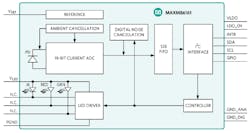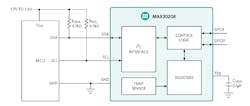Wearable Clinical-Grade Medical Sensors Get Even Smaller
Download this article in PDF format.
Maxim Integrated Products has been at the forefront of medical sensing with development kits like the Health Sensor Platform (HSP). The HSP is a modular smartwatch form factor that can monitor a user’s electrocardiogram (ECG), heart rate, and body temperature.
Its latest products, aimed at the wireless earbud market and similar application areas, are the MAX86161 in-ear heart-rate monitor and its MAX30208 digital temperature sensor. They’re designed to deliver clinical-grade medical results while shrinking size and power requirements that are key to delivering compact mobile devices.
The MAX86161 in-ear heart rate monitor (Fig. 1) delivers best-in-class signal-to-noise ratio (SNR) for continuous heart-rate and oxygen-saturation (SpO2) measurements. It incorporates three programmable, high-current LED drivers, yet only requires a single voltage source from 3.0 to 5.5 V. The receiver uses a high-efficiency PIN photodiode with an optical readout channel. This channel has a low-noise signal conditioning analog front-end (AFE) that consists of a 19-bit ADC, and an ambient-light-cancellation (ALC) circuit to support a picket-fence detect-and-replace algorithm.
1. The MAX86161 in-ear heart rate monitor features optics that are 40% smaller than previous versions.
Maxim’s matching optical solution is 40% smaller than previous versions. The chip comes in a 2.9- × 4.3- × 1.4-mm, 14-pin OLGA package. Maxim also provides algorithms for motion compensation to increase measurement accuracy.
The very low power MAX30208 digital temperature sensor (Fig. 2) has an accuracy of ±0.1°C from 30 to 50°C and ±0.15°C over a wider range from 0 to 70°C. The system, replete with 16-bit resolution, uses a single supply voltage from 1.7 to 3.6 V. The tiny 2- × 2- × 0.75-mm, 10-pin thin LGA chip also incorporates a unique ROM ID that allows the device to be NIST traceable.
2. The MAX30208 digital temperature sensor’s accuracy is ±0.1°C.
About the Author
William G. Wong
Bill Wong is senior content director for Electronic Design.



